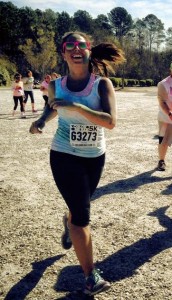 While I was in college, perhaps the lecture that stood out most to me was on proper running form from a Strength & Conditioning class. It wasn’t something I ever really thought about before. My only focus had been getting through my runs without dying! However, whether you are a serious marathon runner or someone who just takes an occasional jog, it is important that you are aware of the way that you hold your body while running. Having proper running form can not only help more serious athletes increase their speed, but also prevents soreness, wear and tear, and injuries in the average runner.
While I was in college, perhaps the lecture that stood out most to me was on proper running form from a Strength & Conditioning class. It wasn’t something I ever really thought about before. My only focus had been getting through my runs without dying! However, whether you are a serious marathon runner or someone who just takes an occasional jog, it is important that you are aware of the way that you hold your body while running. Having proper running form can not only help more serious athletes increase their speed, but also prevents soreness, wear and tear, and injuries in the average runner.
Running is one of my main forms of exercise as I run several miles at least four times per week. I find it to be my biggest stress reliever and my favorite method of cardio conditioning. After learning all about proper running, I have noticed how much longer I am able to maintain my pace without cramping, strain (especially shin splints), or fatigue.
Here's how it's done:
Head
For all exercise, it's important to keep a neutral neck and spine. Hold your head directly above your spine and look ahead or slightly down. Tilting your head backwards or too far towards your chest may strain your neck. Also, relax your face. (It's okay for you to look like a hound dog with their head out a car window! 🙂 ) Your jaw should move freely with your running motion. Tension in your body causes earlier fatigue including the muscles of your face!
Shoulders
Make sure your shoulders are not shrugged up into your neck. They, too, should be relaxed and stretched down towards your torso. Maintain a slight forward tilt to assist with momentum, so your shoulders may end up being slightly in front of your hips.
Arms
Ideally, your arms typically should not cross the mid-line of your body. Keep your elbows at your side and at a 90 degree angle. Allow your arms to move freely from your shoulder joint along your sides, rather than at your elbows. Relax your hands and keep them slightly open as if you are holding a chip. (Again, any tension, a.ka. clenching your fists, causes earlier fatigue).
Hips
Lean slightly forward from your hips to help keep your torso long and propel you forward with momentum. Leaning backward slows you down and put more strain on your back.
Feet
Maintaining dorsiflexion (flexing your feet upward, toes toward the ankles) helps propel you forward due to the elastic recoil in the muscles. As your leading food approaches the ground, land on the ball of your foot rather than your heel. (This is why many people try barefoot running which prevents you from heel striking because it hurts!). Land with your feet directly underneath (or slightly in front of) your center of gravity.
Everybody tends to run in their natural gait. It can be difficult to completely change the way you hold yourself when you run. However, simply thinking about these guidelines while running can help to eventually transform your natural gait to proper running form!
For more on running, check out our the first two posts of this series:

